Oakland, CA Pollen and Allergy Report for Summer 2023
Pollen Allergy Trends in Oakland, CA
When is pollen lowest in Oakland, CA?

February
Lowest month total PPM
Avg. PPM
When is pollen highest in Oakland, CA?

April
Highest month total PPM
Avg. PPM
How does pollen in Oakland, CA compare to California?
Oakland has a lower average PPM than the state of California.
Oakland yearly avg PPM:
California yearly avg PPM:
How does pollen in Oakland, CA compare to the USA?
Oakland has a lower average PPM than the USA.
Oakland yearly avg PPM:
USA yearly avg PPM:
Is pollen worse this year in Oakland, CA?
Spring 2023 was worse than spring 2022.
Spring 2023 PPM:
Spring 2022 PPM:
Average PPM in Oakland, CA
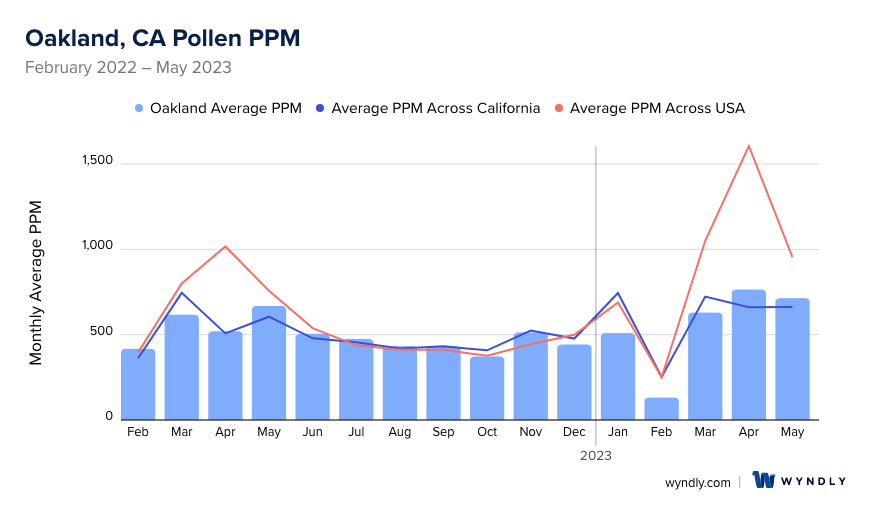
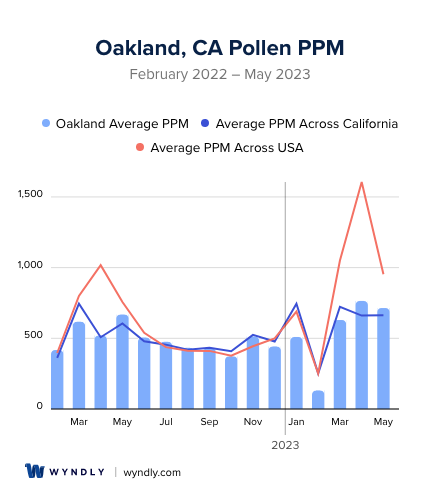
Oakland, CA Pollen and Allergy Breakdown by Month
Grass
When is grass pollen highest in Oakland, CA?
May has the highest grass pollen in Oakland, CA with an average PPM of
When is grass pollen lowest in Oakland, CA?
December has the lowest grass pollen in Oakland, CA with an average PPM of
Tree
When is tree pollen highest in Oakland, CA?
April has the highest tree pollen in Oakland, CA with an average PPM of
When is tree pollen lowest in Oakland, CA?
August has the lowest tree pollen in Oakland, CA with an average PPM of
Weed
When is weed pollen highest in Oakland, CA?
November has the highest weed pollen in Oakland, CA with an average PPM of
When is weed pollen lowest in Oakland, CA?
February has the lowest weed pollen in Oakland, CA with an average PPM of
Oakland, CA Pollen Monthly Breakdown by Pollen Type
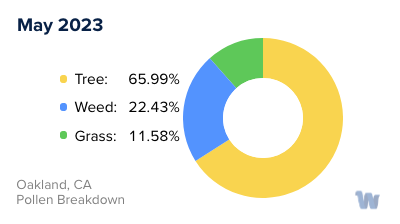
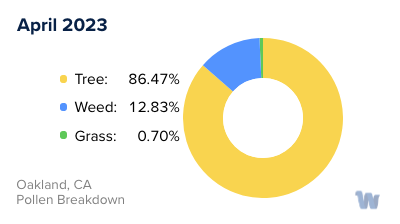
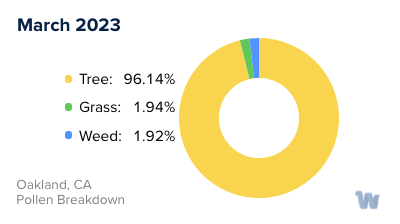
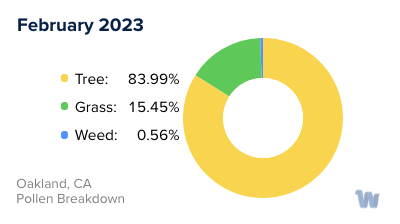
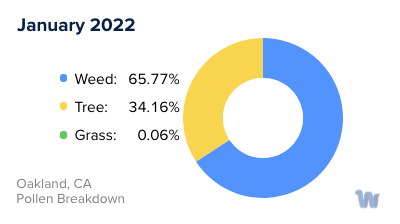
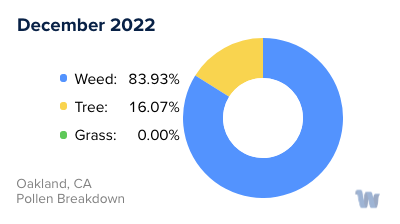
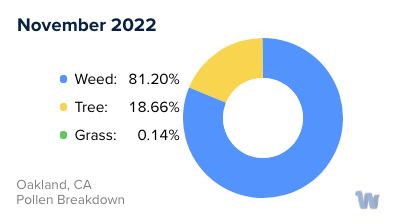

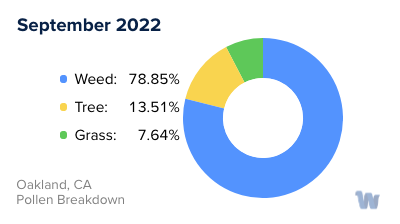
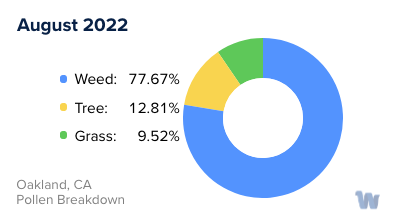
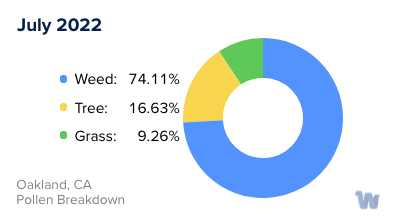
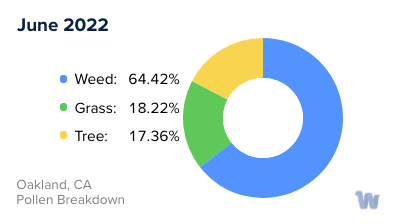
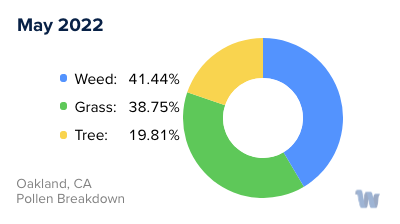
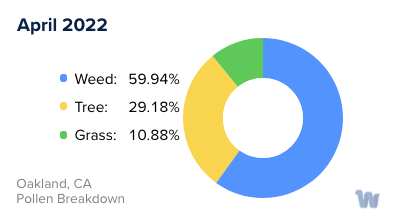
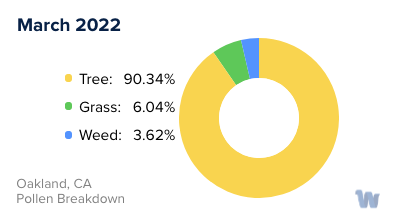
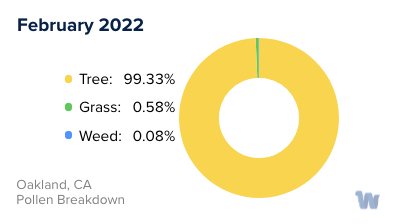
Pollen and Hay Fever in Oakland, CA
Sure, here's a 300-word piece about pollen allergies, also known as hay fever, in Oakland, California.
Pollen allergies, colloquially known as hay fever, are a widespread health concern in Oakland, California. Experiencing these allergies means your immune system sees pollen as a threat and reacts to defend your body, resulting in symptoms like sneezing, itchy eyes, and a runny nose. The type of pollen causing the allergic reaction often depends on the season and the native flora of the area.
In Oakland, there are three primary types of pollen that residents might encounter. These include tree pollen, grass pollen, and weed pollen. Each has its own unique peak season when it is most likely to cause allergic reactions.
Tree pollen typically makes its presence felt in the early spring. The main culprits in Oakland are oak, pine, and cedar trees. These trees release tiny, light grains of pollen that can be carried for miles by the wind. This type of pollen is often the reason for the first wave of hay fever symptoms that people experience each year.
Next comes grass pollen season, which peaks in late spring and early summer. Bermuda grass, ryegrass, and Kentucky bluegrass are the most common sources of this type of pollen in the Oakland area. These grasses are prevalent in lawns, parks, and fields, and their pollen grains can trigger allergic symptoms.
Lastly, weed pollen becomes a concern in late summer and fall. The main offenders in Oakland include ragweed, sagebrush, and lamb's quarters. These weeds can be found in many places, from roadsides to fields, and can cause a significant pollen allergy impact.
Knowing when these pollen types peak can help those living with pollen allergies in Oakland anticipate and prepare for their allergies. It's also important to remember that weather conditions can influence pollen levels, with dry, windy days typically seeing higher concentrations. However, the specific pollen count can vary year to year, so it's always a good idea to keep an eye on local forecasts.
While pollen allergies can be challenging to manage, understanding the seasonal trends and types of pollen prevalent in Oakland, California, is a crucial first step towards navigating life with hay fever.

